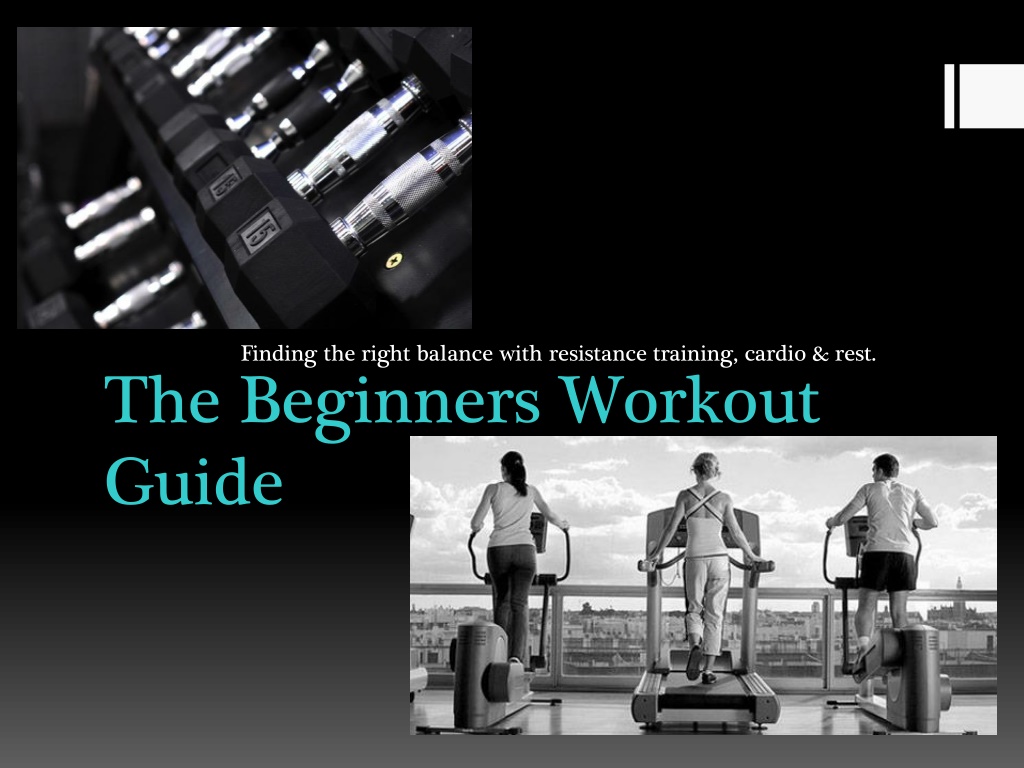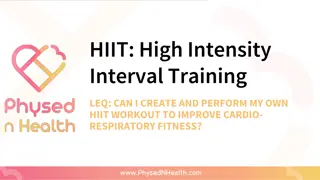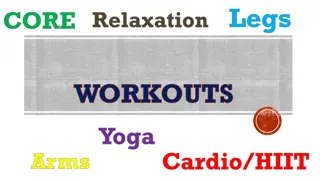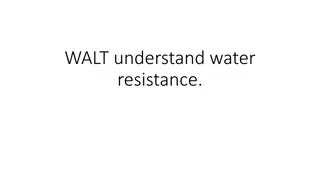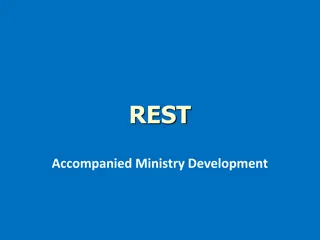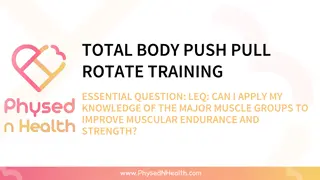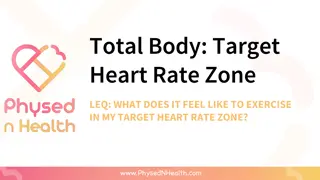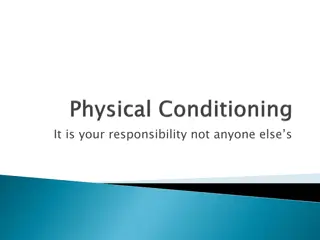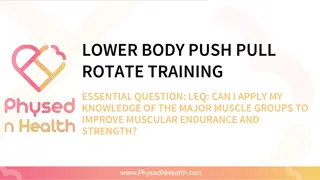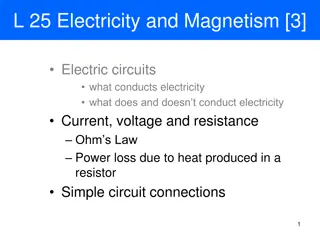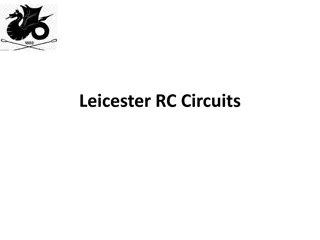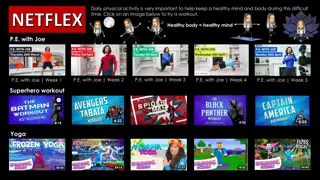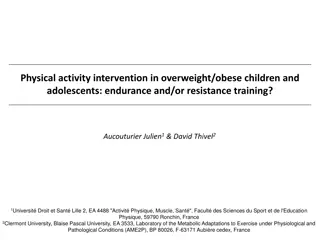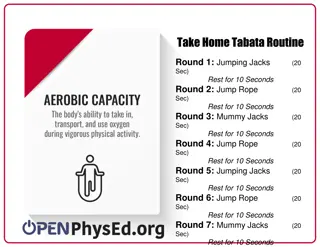Beginner's Workout Guide: Finding the Right Balance with Resistance Training, Cardio, and Rest
Start your fitness journey with a balanced workout routine focusing on resistance training, cardio, and sufficient rest. Set SMART goals, plan your muscle group workouts, and utilize resources to enhance your training experience. Discover the numerous health benefits of weight training, including improved cardiovascular health, increased muscle strength, and body composition changes. Embrace the additional benefits like enhanced flexibility, reduced body fat, and injury prevention, leading to a stronger, healthier body overall.
Download Presentation

Please find below an Image/Link to download the presentation.
The content on the website is provided AS IS for your information and personal use only. It may not be sold, licensed, or shared on other websites without obtaining consent from the author. Download presentation by click this link. If you encounter any issues during the download, it is possible that the publisher has removed the file from their server.
E N D
Presentation Transcript
Finding the right balance with resistance training, cardio & rest. The Beginners Workout Guide
Where do you start? What are your goals? Plan your days (Which muscle group each day?) Write it down Research SMART goals**
Resources to help you Unfamiliar with weight lifting? Do not let that deter you. There are endless resources for you to look up resistance training circuit Pinterest Bodybuilding.com YouTube ** Using the google search engine, you will come across millions of sites that can offer you programs and help with each muscle group Personal Trainers: sign up to work with a trianer at least once a week and you will learn countless exercises as you work with them
Health Benefits of Weight Training Increases HDL - High Density Lipoprotein (good cholesterol) Decreases LDL - Low Density Lipoprotein (bad cholesterol). Reduces risk of: Diabetes & insulin needs Cardiovascular disease Breast cancer (reduces high estrogen levels linked to disease) Osteoporosis (building bone mass) Lowers high blood pressure. Reduces stress and anxiety. Decreases colds and illness.
Strength & Flexibility Benefits Increased muscle strength, power & endurance Enhanced performance of everyday tasks By working the muscles through a full range of motion, weight training can improve your overall body flexibility Increased flexibility reduces the risk of muscle pulls and back pain.
Body Composition Boosted metabolism and BMR (which means burning more calories when at rest) Reduced body fat Overall weight may not change, but you will gain muscle and lose fat Over time you should notice decreases in waist measurements and body-fat measurement
Additional Benefits Strong muscles, tendons and ligaments All are less likely to give way under stress Less likely to be injured. Increased bone density and strength reduces back and joint pain by building muscle around these areas More conditioned, firm & defined muscles Improved balance, stability & posture
Basic Principles Type of lift Intensity Volume Variety Overload Rest Recovery
5 days/week Back & biceps Chest & triceps Legs Shoulders Arms 3-4 days/week Chest & back Biceps and triceps Legs & shoulders Cardio Examples of Lifting Splits
Splits explained Lifting splits are muscle groups you assign to each day of the week. You can work cardio around it as well as do cardio and lift weights the same day. These are just examples; you can create your own. Resistance training & cardio can be tailored to your needs whether they be goal-based, time-based, etc.
Remember, a workout is about PUSHING yourselfoutside of your comfort zone to get the results you want Also, remember if it were easy, then everyone would be doing it You can increase intensity by doing more repetitions, more sets, heavier weights or decreasing rest times between sets
Volume & Variety The quantity of your workouts or duration Increase or decrease the volume by either training more or less often per week or by training for longer or shorter periods of time Switching around your workout routine Vary your workouts by changing exercises, the rep scheme or your training volume Variety challenges your muscles and forces them to adapt with increased size and strength Do NOT do the same thing every day or week the body WILL adapt
Overload is not as intimidating as it sounds Progressively try doing more reps as well as heavier weights Rest between your sets: You may rest 30-60 seconds if your focus is endurance or for 2-4 minutes if you are using heavier weights with strength as your focus Both ways will increase calories burned Recovery is as important as being active; allow your muscle groups around 48 hours to recover Overload, Rest & Recovery
What to use? For resistance training, there are really only three general categories to use: Weight machines Free weights (including miscellaneous things such as medicine balls, resistance bands, etc) Your own body (push ups, pull ups, etc)
Watch your form When beginning weight training, you want to be aware of the correct form. Research, fellow gym friends or a personal trainer can help you with this. For example, when squatting you DO NOT want your knees beyond your toes; you want your weight to be distributed in your heels. Safety first!
Cardio vs. Resistance Training Both are extremely important Yes, you may lose more weight with strictly aerobic exercise but you will lose more fat with resistance training or a happy balance between both aerobic and weight training exercise The scale is NOT a good gage .. Does it measure composition? NO. Gaining muscle inevitably means you are losing fat
Depends on your goals Your body adapts very quickly 3-4 times a week at most (with proper diet and resistance training) is appropriate amount Change it up Try HIIT (High intensity interval training) Make sure your body cannot catch up or adjust this yields results HIIT can be done in 20-25 min Try 2-3 days HIIT and 1-2 days of steady state but moderate intensity cardio
Research routines; many out there 15 seconds up to 1 minute intervals of high intensity, all out followed by 1-2 minutes of recovery/low intensity Can be done on any machine May do this at home Burpees, mountain climbers, jump rope, jumping jacks, high knees, squat jumps, etc Simply doing 5-10 minutes of cardio and switching machines will trick your body. Example: Run 10 minutes on treadmill with an incline, 10 minutes hard on elliptical with moderate resistance, 5 minutes high level on Stairmaster, etc.
More Muscle, Less Fat This should be the focus. Don t rely 100% on the scale. Rely on your hard work, energy levels, how your clothes fit and progress pictures!
